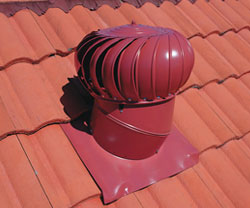Roof Ventilation
The most important goal of roof ventilation is to allow a consistent flow of fresh air to go through your home’s loft. There are two primary reasons why this is so important. The first is because proper ventilation will ensure that a loft’s insulation is as efficient as possible. The other reason is that keeping a loft ventilated will help keep the temperature throughout the rest of a space at a desirable temperature. Because it will require less energy to heat or cool a space, this consistency will reduce your utility bills.
How Does Roof Ventilation Work?
Roof ventilation functions by creating a balance between air exhaust and intake. The exhaust components will be placed around the ridge of your roof, while the intake components will be added to soffits or eaves. In order for your roof ventilation to be as efficient as possible, there are certain guidelines you will want to follow. These guidelines involve the optimal amount of ventilation space. This number can be found with just a few steps:
- Determine the size of your loft in square feet
- Allocate one square foot of ventilation per 300 square feet of space
- Evenly divide the allocated space between exhaust and intake
Once you’ve determined how much roof ventilation you need to ensure that air consistently flows through your loft space, you will want to decide which types of vents to use. Because there are everything from ridge vents to rotary turbine vents, you may be confused about which options to choose. Luckily, there are two simple tips that can make this decision easier. In addition to remembering that it’s generally best to use multiple types of vents in conjunction with each other, don’t forget that the most important factor is that the vents you choose are optimized for your home and the climate of your surrounding area.
Is Roof Ventilation Actually a Priority?
If you want to avoid costly problems and ensure that your home lasts for as long as possible, roof ventilation should be a priority. While you may think that poor ventilation only impacts your loft, it can actually have an effect on your entire home. For example, if a loft isn’t ventilated, it will get extremely hot during the summer. When this occurs, the excess heat will eventually make its way into other rooms and raise your entire energy bill.
Are There Other Problems That Can Arise from Neglecting Roof Ventilation?
There are quite a few other problems that can occur if poor ventilation isn’t fixed. It’s common for shingles to get worn out in less time when they’re on a roof that isn’t properly ventilated. The wood frame of a roof can eventually crack or even break. Additionally, the high temperatures and moisture accumulation that result from poor ventilation can cause mold to begin growing. If this happens, mold can quickly spread to other parts of your home. Not only is it expensive to get mold removed, but not dealing with the core cause means it's likely to return.

Categories
- Home
- Types Of Loft Ventilation
- Attic Ventilation
- Heat Recovery Ventilation
- Industrial Loft Ventilation
- Loft Roof Space Ventilation
- Natural Ventilation
- Pigeon Loft Ventilation
- Positive Pressure Loft Ventilation System
- Proper Roof Ventilation
- Roof Ventilation
- Soffit Loft Ventilation
- Solar Ventilation
- Loft Ventilation Companies
- Loft Ventilation Information
- Loft Ventilation Products
